|
|

Handbook on Viewing Buddhist Statues
A totally wonderful
book by Ishii Ayako.
Some images
at this site were
scanned from this
book; Japanese
language only;
192 pages;
80+ color photos
Click here to
buy book at Amazon
|
|

TAISHAKUTEN, TAISHAKU, 帝釈天
SANSKRIT = ŚAKRA DEVA, INDRA
Lord of the Center, Commander of Four Heavenly Kings
Rules Heaven of 33 Gods (Skt. = Trayastrimasha)
ORIGIN = Hindu deity incorporated into Buddhism.
Member of the TENBU, SHITENNŌ, JUNITEN, DEVA, NIJŪHACHI BUSHŪ.
Governs the Shitennō (Guardians of East, West, North, South).
|
Japanese Mantra
おん しゃきらや そわか
On Shakiraya Sowaka
(also Om Shakiraya Sowaka)
Translation
OM, HAIL ŚAKRA DEVA
Shakiraya = Japanese
transliteration of Sanskrit Śakra
|
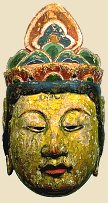
Taishakuten Mask, Heian Era
Kyoto National Museum
|

Sanskrit Seed
for Taishakuten
Pronounced ii in Japan
|
|
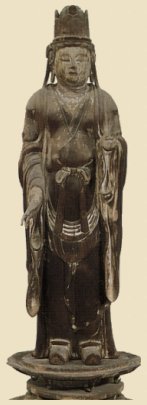
Taishakuten
Wood with gold leaf
Heian Era, 10th Century
Hōryūji Temple 法隆寺, Nara
|
|
 Taishakuten 帝釈天 is known in Sanskrit as Indra, Śakra, Sakradevanam Indra (Śakra-devānām Indra), or Shakra Devanam Indra. Positioned in Center. Buddhists in Tibet, China, and Japan have adopted Taishakuten as their guardian deity. In India, Indra was the ruler of the gods of the Veda. Not only was he the mightiest of gods, but also the god of storms, thunder, and war. Taishakuten 帝釈天 is known in Sanskrit as Indra, Śakra, Sakradevanam Indra (Śakra-devānām Indra), or Shakra Devanam Indra. Positioned in Center. Buddhists in Tibet, China, and Japan have adopted Taishakuten as their guardian deity. In India, Indra was the ruler of the gods of the Veda. Not only was he the mightiest of gods, but also the god of storms, thunder, and war.
Once incorporated into Buddhism, Taishakuten becomes one of its greatest protectors. Said to live in the Palace of Correct Views (Jp. = Zenkenjō 善見城) located in the Trayastriṃśas (Skt.) Heaven on the peak of Mt. Shumisen 須弥山 (Mt. Sumeru or Mt. Meru, the mythical home of the Historical Buddha, the center of the Buddhist universe). There he governs the other 32 gods of that heaven, and is served in particular by the Shitenno (Four Heavenly Kings). He is also known as a god of wealth in Japan.
Taishakuten defends both deities and humans against all that is evil. Able to revive those slain in battle, Taishakuten has attributes of both a creator and a sun god. In the Rig Veda are found more hymns to Indra's dedication than any other. In his home, he let no suffering or sorrow pass. At his court the Gandharva (Kendabba) entertained. Taishaku is, in some ways, similar to Zeus in Greek mythology.
In Japanese artwork, Taishakuten is often depicted riding an elephant. This reflects his Hindu origin, for in India an elephant serves as the mount of Indra. In India, Indra often rides an elephant with 33 heads and 33 tusks named Erawan (Airavata). In Buddhist traditions, this symbolizes the 33 gods of the Trayastrimsha Heaven. Erawan, however, is often depicted as a three-headed elephant in artwork. The elephant is also closely associated with Shaka Nyorai (the Historical Buddha). According to Buddhist mythology, when Shaka was 72 years old, his cousin and brother-in-law, the malevolent Devadatta, hoped to displace the Buddha and take over leadership of the Sangha (Buddhist community). Devadatta released an elephant maddened with alcohol upon the Buddha, but the elephant was struck by Shaka's spiritual power and fell prostrate before him. Some art historians claim this is the origin of the Semui-in Mudra (the “Fear Not” hand gesture) found commonly throughout Asia on statues of the Buddha. In other lore, Queen Maya, the mother of the Historical Buddha, dreamt of an elephant before giving birth to the Buddha. In his prior lives, it is said, the Buddha was once an elephant. Elephant symbolism is also found in Japanese artwork of Fugen Bosatsu, who is commonly depicted riding an elephant as described in the Lotus Sutra.
More on Elephant Symbolism. In India, the Hindu god Ganesh (also Ganesha; in Japan called Kankiten) is portrayed with the head of an elephant, and assists believers in overcoming all obstacles -- akin to the force of an elephant crashing through the jungle. The son of Parvati, Ganesh removes every difficulty and is invoked at the start of any new enterprise. The elephant may also symbolize unrestrained passion. In Japan, the elephant is also closely associated with Fugen Bodhisattva, who is often portraying sitting atop the beast, which symbolizes the overcoming of obstacles. In Japanese artwork, the Buddhist deity Taishakuten (Sanskrit = Indra) is likewise depicted frequently riding an elephant.

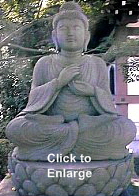 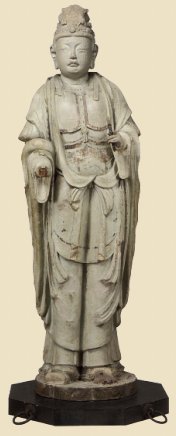 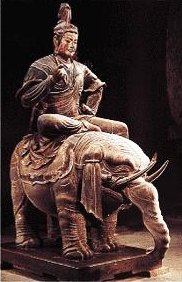
Left: Modern stone statue of Taishakuten, Hase Dera, Kamakura
Center: Taishakuten, Clay with gold leaf, 8th C., Hōryūji Temple 法隆寺, Nara,
Right: Taishakuten, 9th Century, Tōji Temple 東寺, Kyoto

LEARN MORE
- Buddhist-Artwork.com, our sister estore, offers statues of the Shitennō.
- Shitennō, Four Heavenly Kings. Four Deva Kings. Guardians of East, West, North, South (the four cardinal directions). The Shitennō are also associated with four legendary creatures of Chinese mythology (dragon, red bird, tiger, turtle). See Shijin (Four Celestial Emblems) for more on these four creatures.
- In the Japanese Mandala, the Shitennō (Guardians of the Four Directions) are typically shown, from the top, starting with the eastern guardian. Thus, the typical order is Jikokuten (East), Zōchōten (South), Kōmokuten (West), and Tamonten (North).
- 28 Constellations, 28 Moon Lodges, 28 Moon Stations (this site)
Learn more about each of the four quarters (north, south, east, west) and the seven constellations in each group. All 28 represent points in the moon’s monthly path, and each was deified.
- Butsuzō-zu-i 仏像図彙, the “Collected Illustrations of Buddhist Images.” Published in 1690. One of Japan’s first major studies of Buddhist iconography. Hundreds of pages and drawings, with deities classified into approximately 80 (eighty) categories. Modern-day reprints of the expanded Meiji-era version are available at this online store (J-site).
- Mandara Zuten 曼荼羅図典 (Japanese Edition). The Mandala Dictionary. 422 pages. First published in 1993. Publisher Daihorinkaku 大法輪閣. Language Japanese. ISBN-10: 480461102-9. Available at Amazon.
- JAANUS. Japanese Architecture & Art Net Users System. Compiled by the late Dr. Mary Neighbour Parent; covers both Buddhist and Shintō deities in great detail and contains over 8,000 entries.
- A Dictionary of Chinese Buddhist Terms. With Sanskrit & English Equivalents. Plus Sanskrit-Pali Index. By William Edward Soothill & Lewis Hodous. Hardcover, 530 pages. Published by Munshirm Manoharlal. Reprinted March 31, 2005. ISBN 8121511453.
- Digital Dictionary of Chinese Buddhism (C. Muller; login "guest")
- Buddhism: Flammarion Iconographic Guides, by Louis Frederic, Printed in France, ISBN 2-08013-558-9, First published 1995.
- 4 Heavenly Kings, Great Mandala Study Group (outside link). Also see Four Heavenly Kings, Nichiren Tradition (outside link). “They appear in the ceremony of the Lotus Sutra with their 10,000 retainer gods in the Dharani (26th chapter). Therein, Jikokuten and Bishamonten pledge on behalf of all four to protect those who embrace the Lotus Sutra.
- Four Heavenly Kings (J-site, outside link), plus Sanskrit characters used herein.
- See Bibliography for our complete list of resources on Japanese Buddhism
- Lives here: http://wkdkigodatabase03.blogspot.com/2007/04/kiken-castle-kikenjoo.html
see 33 kamakura kannon page for text
- More About Taishaku (Below text courtesy Sokka Gakkai USA, #17)
Taishakuten is one of the two main tutelary gods of Buddhism, together with Bonten (Skt. = Brahman or Sikhin). He is also one of the Juniten, or Twelve Devas, said to protect the world. Originally the god of thunder in Indian mythology, he was later incorporated into Buddhism as a protective deity. He lives in a palace called Correct Views (Jp. = Zenkenjō 善見城) or Joyful to See (Kikenjō) in the Trayastrimsha Heaven on the peak of Mt. Sumeru and, served by the Four Heavenly Kings, governs the other thirty-two gods of that heaven. While Shakyamuni was engaged in bodhisattva practice, Taishaku is said to have assumed various forms to test his resolve. According to the Jo (first) chapter of the Lotus Sutra, he joined the assembly on Eagle Peak, accompanied by twenty thousand retainers, to hear the Historical Buddha speak.

|
|